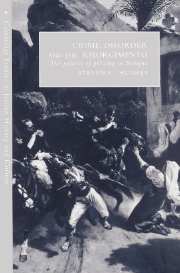Book contents
- Frontmatter
- Contents
- List of illustrations and tables
- Acknowledgments
- List of abbreviations and note on footnotes
- Map 1 Primary political divisions of the Papal States in 1842
- Map 2 Legation of Bologna 1821
- Introduction
- 1 Setting the stage: Bologna, the ancien régime, and Napoleon
- 2 Consalvi's cops
- 3 Functions and failures (1815–1831)
- 4 Public order and the revolution of 1831
- 5 Reform and failure (1832–1847)
- 6 Reform and revolution (1847–1849)
- 7 The search for stability and the turn to Piedmont (1849–1859)
- 8 Epilogue: Risorgimento, freedom, and repression
- 9 Conclusion
- Appendix A Personnel plans of Bologna's Provincial Police, 1816–1863
- Appendix B The pattern of crime in Bologna, 1819–1846
- Index
Appendix B - The pattern of crime in Bologna, 1819–1846
Published online by Cambridge University Press: 06 July 2010
- Frontmatter
- Contents
- List of illustrations and tables
- Acknowledgments
- List of abbreviations and note on footnotes
- Map 1 Primary political divisions of the Papal States in 1842
- Map 2 Legation of Bologna 1821
- Introduction
- 1 Setting the stage: Bologna, the ancien régime, and Napoleon
- 2 Consalvi's cops
- 3 Functions and failures (1815–1831)
- 4 Public order and the revolution of 1831
- 5 Reform and failure (1832–1847)
- 6 Reform and revolution (1847–1849)
- 7 The search for stability and the turn to Piedmont (1849–1859)
- 8 Epilogue: Risorgimento, freedom, and repression
- 9 Conclusion
- Appendix A Personnel plans of Bologna's Provincial Police, 1816–1863
- Appendix B The pattern of crime in Bologna, 1819–1846
- Index
Summary
As in other European cities after the restoration, crime, especially street and property crime, greatly concerned Bologna's administrators and citizens. Their fear of crime peaked around the years 1827–1830 and 1843–1846, when publicly perceived “crime waves” led elite citizens to begin patrolling the streets themselves, in the latter case against the express wishes of the government. Did such “crime waves” actually occur? Or were they the figment of Bologna's upper class collective imagination, inspired by a general spirit of deprecation against the papal regime's inefficiency and political repression? The perception of insecurity was real enough, as witnessed by the letters to the Pope, the complaints among friends, and the stream of articles on crime that began in 1843. But what reality lay behind this perception? The available evidence, although not infallible, strongly indicates that the Bolognesi were reacting to very real increases in crime, albeit a certain variety of crime, when they armed and organized themselves into deterrent patrols.
THE EVIDENCE
In response to an abortive attempt to arouse the masses in 1843, the cardinal legate of Bologna, Luigi Vannicelli Casoni, ordered the compilation of crime statistics for both the city and the province since 1810 in order to assess the current situation. His subordinates extracted these statistics from the protocolli criminali of Bologna's criminal courts, arranging them in a table or Quadro Sinottico that eventually included information through the first semester of 1846.
- Type
- Chapter
- Information
- Crime, Disorder, and the RisorgimentoThe Politics of Policing in Bologna, pp. 273 - 279Publisher: Cambridge University PressPrint publication year: 1994



